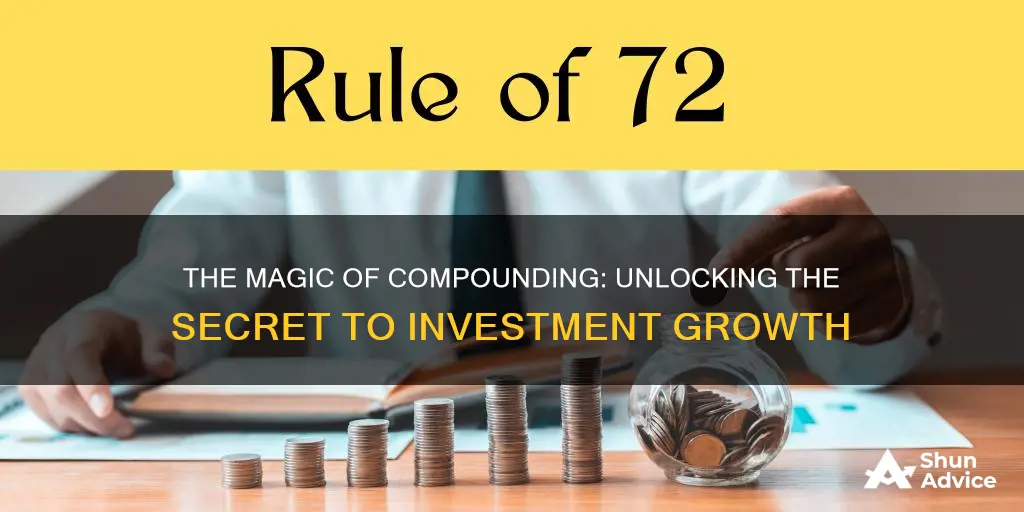
The Rule of 72 is a simple way to determine how long an investment will take to double, given a fixed annual rate of interest. It is a useful rule of thumb for investors to estimate how long it will take to double their money. The rule states that by dividing 72 by the annual rate of return, investors can get a rough estimate of how many years it will take for their initial investment to duplicate itself. For example, if an investment earns 6% per year on average, it will take 12 years for the money to double.
| Characteristics | Values |
|---|---|
| Rule of 72 | A quick, useful formula to estimate the number of years required to double the invested money at a given annual rate of return |
| Rule of 72 calculation | 72 / Expected Rate of Return |
| Rule of 72 accuracy | Most accurate for rates of return between 6% and 10% |
| Rule of 72 alternatives | Rule of 69, Rule of 70, Rule of 73 |
| Rule of 72 application | Can be applied to anything that increases exponentially, such as GDP or inflation |
What You'll Learn
- The Rule of 72: a formula to estimate how long it takes to double an investment
- The Rule of 72 is most accurate for interest rates between 6% and 10%
- The Rule of 72 can be used to estimate the rate of return needed for an investment to double
- The Rule of 72 can be adjusted for higher accuracy
- The Rule of 72 can be used to estimate how much to invest to reach a goal

The Rule of 72: a formula to estimate how long it takes to double an investment
The Rule of 72 is a formula used to estimate how long an investment will take to double at a given fixed annual rate of interest. It is a simplified version of the compound interest calculation.
The Rule of 72 formula is: Years to Double = 72 / rate of return on investment (or interest rate).
For example, if your investment earns 4% a year, it would take about 72 / 4 = 18 years to double.
This rule can also be used to estimate how long it will take for the value of money to halve due to inflation. Divide 72 by the inflation rate to estimate how many years it will take for your money's buying power to be cut in half.
The Rule of 72 is reasonably accurate for interest rates that fall in the range of 5% to 10%. The higher the interest rate, the less precise the result will be. For more accurate results, divide 69.3 by the rate of return.
The Rule of 72 is a useful tool for anyone starting their investment journey as it highlights the importance of early investing and the power of compounding interest.
Retirement Investments: Where Do Seniors Put Their Money?
You may want to see also

The Rule of 72 is most accurate for interest rates between 6% and 10%
The Rule of 72 is a formula used to estimate the number of years required for an investment to double, based on its rate of return. It is calculated by dividing 72 by the expected rate of return. For example, if an investment scheme promises an 8% annual compounded rate of return, it will take approximately nine years (72 / 8 = 9) to double the invested money.
The Rule of 72 is a simplified formula that is reasonably accurate for interest rates that fall in the range of 6% and 10%. It is particularly useful for mental calculations and quick approximations, as it is easy to comprehend and calculate. For instance, if an investment earns 6% per year, dividing 72 by 6 indicates that it will take 12 years for the investment to double.
While the Rule of 72 is a handy estimation tool, it is important to note that it is not entirely precise. For more accurate calculations, the Rule of 69 or 69.3 can be used, although these may be less convenient for mental calculations. The Rule of 70 is also a closer approximation to the true time value of money.
Additionally, the Rule of 72 assumes a constant rate of return each year, which may not reflect the volatility of real-life investment returns. It also does not account for factors such as inflation, tax rates, or investment fees, which can significantly impact investment returns.
In summary, the Rule of 72 is most accurate for interest rates between 6% and 10%, providing a quick and simple way to estimate how long it will take for an investment to double. However, for more precise calculations, adjustments or alternative rules can be considered.
Amazon: A Worthy Investment
You may want to see also

The Rule of 72 can be used to estimate the rate of return needed for an investment to double
The Rule of 72 is a formula that can be used to estimate the number of years required for an investment to double at a given annual rate of return. It is calculated by dividing 72 by the expected rate of return. For example, if an investment scheme promises an 8% annual compounded rate of return, it will take approximately nine years (72 / 8 = 9) to double the invested money.
The Rule of 72 can also be used to estimate the rate of return needed for an investment to double given an investment period. For instance, if you want to double your money in five years, divide 72 by five to determine that you'll need to earn 14.4% interest annually (72 / 5 = 14.4).
The Rule of 72 is a simplified formula that is often taught to beginning investors as it is easy to comprehend and calculate. It is reasonably accurate for interest rates that fall in the range of 6% to 10%.
The Rule of 72 can be applied to anything that increases exponentially, such as GDP or inflation. It can also be used to indicate the long-term effect of annual fees on an investment's growth. For example, a mutual fund that charges 3% in annual expense fees will reduce the investment principal to half in around 24 years.
While the Rule of 72 provides a quick and useful estimate, it is important to note that it is not entirely precise. For more accurate calculations, investors can use the Rule of 69.3 or the Rule of 70, or refer to online compound interest calculators.
Stock Market: Invest Now or Later?
You may want to see also

The Rule of 72 can be adjusted for higher accuracy
The Rule of 72 is a simplified formula that calculates how long it will take for an investment to double in value, based on its rate of return. It is a quick and useful formula that is often used to estimate the number of years required to double the invested money at a given annual rate of return.
The Rule of 72 is reasonably accurate for interest rates that fall between 6% and 10%. It is less accurate for higher interest rates. For higher rates, a larger numerator would be better. The rule of 72 can be adjusted for higher accuracy by adding or subtracting 1 from 72 for every 3 points the interest rate diverges from the 8% threshold. For example, for a 5% rate of return, the rule of 71 would be used, while for an 11% rate of return, the rule of 73 would be used.
The Rule of 72 can also be adjusted to more closely resemble the compound interest formula, effectively transforming it into the Rule of 69.3. The Rule of 69.3 is more accurate for continuous compounding, while the Rule of 72 works well in common interest situations and is more easily divisible. The Rule of 69.3 is preferred by many investors as it provides maximum accuracy, particularly for continuous compounding interest rate instruments.
Annuity Advantage: Unlocking a Lifetime of Financial Freedom
You may want to see also

The Rule of 72 can be used to estimate how much to invest to reach a goal
The Rule of 72 is a formula that can be used to estimate the number of years required for an investment to double at a given annual rate of return. It can also be used to estimate the annual rate of return that would be needed to double an investment in a given number of years.
The Rule of 72 is calculated by dividing 72 by either the expected rate of return or the number of years in which you want to double your investment. For example, if you expect an annual rate of return of 8%, it would take approximately nine years for your investment to double in value (72 / 8 = 9). On the other hand, if you want to double your investment in six years, you would need an annual rate of return of 12% (72 / 6 = 12).
The Rule of 72 is a useful tool for investors to quickly estimate how much they need to invest to reach a particular goal. For example, if your goal is to have $1 million by age 65 and you are currently 35, you know you have 30 years to reach that goal. Based on the Rule of 72, you would only need to earn a rate of return of 2.4% to double your money in 30 years (72 / 30 = 2.4). So, if you have $500,000 saved now, you can invest it fairly conservatively and still reach your goal without making any other contributions.
The Rule of 72 is most accurate for rates of return between 6% and 10%. For rates of return outside this range, the rule can be adjusted by adding or subtracting 1 from 72 for every 3 points the interest rate diverges from 8%. For example, for a rate of return of 11%, you would use the Rule of 73 for higher precision (72 + 1 = 73).
While the Rule of 72 is a useful estimation tool, it is important to note that it assumes a constant rate of return each year, which may not reflect reality. It also does not take into account factors such as investment fees, taxes, and inflation, which can impact investment returns. For more precise calculations, investors can use online compound interest calculators or seek advice from a financial advisor.
Maximizing Your Inheritance: Smart Investment Strategies to Minimize Tax Burdens
You may want to see also
Frequently asked questions
The Rule of 72 is a formula that estimates how long it will take for an investment to double based on its rate of return. It is calculated by dividing 72 by the expected rate of return.
To use the Rule of 72, divide 72 by the expected annual return of your investment. The result is the approximate number of years it will take for your initial investment to double.
The Rule of 72 is used to estimate how long it will take for an investment to double in value. It can also be used to estimate the rate of return needed to double an investment in a given number of years.
The Rule of 72 is a simplified formula and may not provide precise results. It is most accurate for rates of return between 5% and 10%. It also assumes a constant rate of return, which may not reflect the volatility of investment returns.
Yes, there are alternative formulas that can provide more precise estimates. For example, dividing 69.3 or 70 by the rate of return can give a more accurate estimate while still allowing for relatively easy mental calculations.







